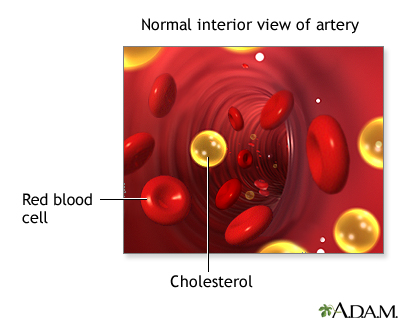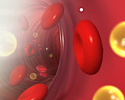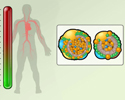Cholesterol testing and results
Cholesterol test results; LDL test results; VLDL test results; HDL test results; Coronary risk profile results; Hyperlipidemia-results; Lipid disorder test results
Cholesterol is a soft, wax-like substance found in all parts of the body. Your body needs a little bit of cholesterol to work properly. But too much cholesterol can clog your arteries and lead to heart disease.
Cholesterol blood tests are done to help you and your health care provider better understand your risk for heart disease, stroke, and other problems caused by narrowed or blocked arteries.
The ideal values for all cholesterol results depend on whether you have heart disease, diabetes, or other risk factors. Your provider can tell you what your goal should be.
Cholesterol Tests
Some cholesterol is considered good and some is considered bad. Different blood tests can be done to measure each type of cholesterol.
Your provider may order only a total cholesterol level as the first test. It measures all types of cholesterol in your blood.
You may also have a lipid (or coronary risk) profile, which includes:
- Total cholesterol
- Low density lipoprotein (LDL cholesterol)
- High density lipoprotein (HDL cholesterol)
-
Triglycerides
(another type of fat in your blood)
Triglycerides
The triglyceride level is a blood test to measure the amount of triglycerides in your blood. Triglycerides are a type of fat. Your body makes some t...
 ImageRead Article Now Book Mark Article
ImageRead Article Now Book Mark Article - Very low density lipoprotein (VLDL cholesterol)
Lipoproteins are made of fat and protein. They carry cholesterol, triglycerides, and other fats, called lipids, in the blood to various parts of the body.
When Should You Be Tested?
Everyone should have their first screening test by age 35 for men, and age 45 for women. Some guidelines recommend starting at age 20.
You should have a cholesterol test done at an earlier age if you have:
- Diabetes
- Heart disease
- Stroke
- High blood pressure
- A strong family history of heart disease
Follow-up testing should be done:
- Every 5 years if your results were normal
- More often for people with diabetes, high blood pressure, heart disease, stroke, or blood flow problems to the legs or feet
- Every year or so if you are taking medicines to control high cholesterol
Total Cholesterol
A total cholesterol of 180 to 200 mg/dL or less is considered best.
You may not need more cholesterol tests if your cholesterol is in this normal range.
LDL (Bad) Cholesterol
LDL cholesterol is sometimes called "bad" cholesterol. LDL can clog your arteries.
You want your LDL to be low. Too much LDL is linked to heart disease and stroke.
Your LDL is most often considered to be too high if it is 190 mg/dL or higher.
Levels between 70 and 189 mg/dL are most often considered too high if:
- You have diabetes and are between ages 40 and 75
- You have diabetes and a high risk of heart disease
- You have a medium or high risk of heart disease
Health care providers have traditionally set a target level for your LDL cholesterol if you are being treated with medicines to lower your cholesterol .
Treated with medicines to lower your ch...
Hyperlipidemia - drug treatment; Hardening of the arteries - statin

- Some newer guidelines now suggest that providers no longer need to target a specific number for your LDL cholesterol. Higher strength medicines are used for the highest risk patients.
- However, some guidelines still recommend using specific targets.
HDL (Good) Cholesterol
You want your HDL cholesterol to be high. Studies of both men and women have shown that the higher your HDL, the lower your risk of coronary artery disease. This is why HDL is sometimes referred to as "good" cholesterol.
HDL cholesterol levels greater than 40 to 60 mg/dL are desired.
VLDL (Bad) Cholesterol
VLDL contains the highest amount of triglycerides. VLDL is considered a type of bad cholesterol, because it helps cholesterol build up on the walls of arteries.
Normal VLDL levels are from 2 to 30 mg/dL.
Considerations
Sometimes, your cholesterol levels may be low enough that your provider will not ask you to change your diet or take any medicines.
References
American Diabetes Association. Standards of medical care in diabetes -- 2014. Diabetes Care. 2014;37 Suppl 1:S14-S80.
Gennest J, Libby P. Lipoprotein disorders and cardiovascular disease. In: Bonow RO, Mann DL, Zipes DP, Libby P, eds. Braunwald's Heart Disease: A Textbook of Cardiovascular Medicine. 9th ed. Philadelphia, PA: Elsevier Saunders; 2011:chap 45.
Pencina MJ, Navar-Boggan AM, D'Agostino RB Sr, Williams K, Neely B, Sniderman AD, Peterson ED. Application of new cholesterol guidelines to a population-based sample. N Engl J Med . 2014 Apr 10;370(15):1422-1431. PMID: 24645848 www.ncbi.nlm.nih.gov/pubmed/24645848 .
Stone NJ, Robinson J, Lichtenstein AH, et al. 2013 ACC/AHA Guideline on the Treatment of Blood Cholesterol to Reduce Atherosclerotic Cardiovascular Risk in Adults. J Am Coll Cardiol. 2014 Jul 1;63(25 Pt B):2889-934. PMID: 24239923 www.ncbi.nlm.nih.gov/pubmed/24239923 .
Stone NJ, Robinson JG, Lichtenstein AH, Goff DC Jr, Lloyd-Jones DM, Smith SC Jr, et al. Treatment of blood cholesterol to reduce atherosclerotic cardiovascular disease risk in adults: Synopsis of the 2013 American College of Cardiology/American Heart Association cholesterol guideline. Ann Intern Med. 2014 Mar 4;160(5):339-43.
-
Understanding cholesterol results
Animation
-
Heart disease modifiable risk factors - hyperlipidemia
Animation
-
Cholesterol - illustration
Cholesterol is a soft, waxy substance that is present in all parts of the body including the nervous system, skin, muscle, liver, intestines, and heart. It is made by the body and obtained from animal products in the diet. Cholesterol is manufactured in the liver and is needed for normal body functions including the production of hormones, bile acid, and Vitamin D. Excessive cholesterol in the blood contributes to atherosclerosis and subsequent heart disease. The risk of developing heart disease or atherosclerosis increases as the level of blood cholesterol increases.
Cholesterol
illustration
-
Understanding cholesterol results
Animation
-
Heart disease modifiable risk factors - hyperlipidemia
Animation
-
Cholesterol - illustration
Cholesterol is a soft, waxy substance that is present in all parts of the body including the nervous system, skin, muscle, liver, intestines, and heart. It is made by the body and obtained from animal products in the diet. Cholesterol is manufactured in the liver and is needed for normal body functions including the production of hormones, bile acid, and Vitamin D. Excessive cholesterol in the blood contributes to atherosclerosis and subsequent heart disease. The risk of developing heart disease or atherosclerosis increases as the level of blood cholesterol increases.
Cholesterol
illustration
-
Cholesterol
(In-Depth)
Review Date: 11/26/2014
Reviewed By: Michael A. Chen, MD, PhD, Associate Professor of Medicine, Division of Cardiology, Harborview Medical Center, University of Washington Medical School, Seattle, WA. Also reviewed by David Zieve, MD, MHA, Isla Ogilvie, PhD, and the A.D.A.M. Editorial team.




